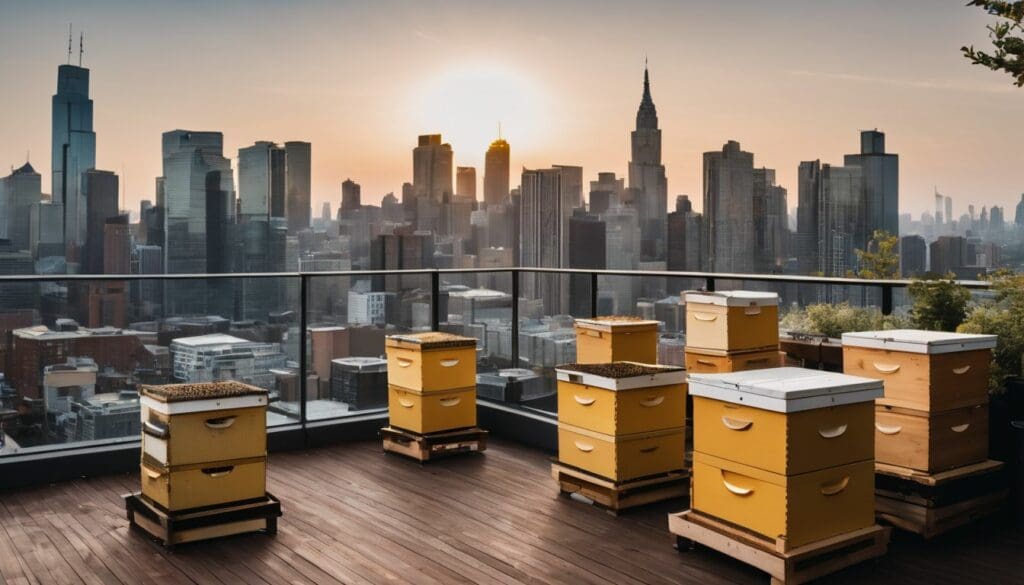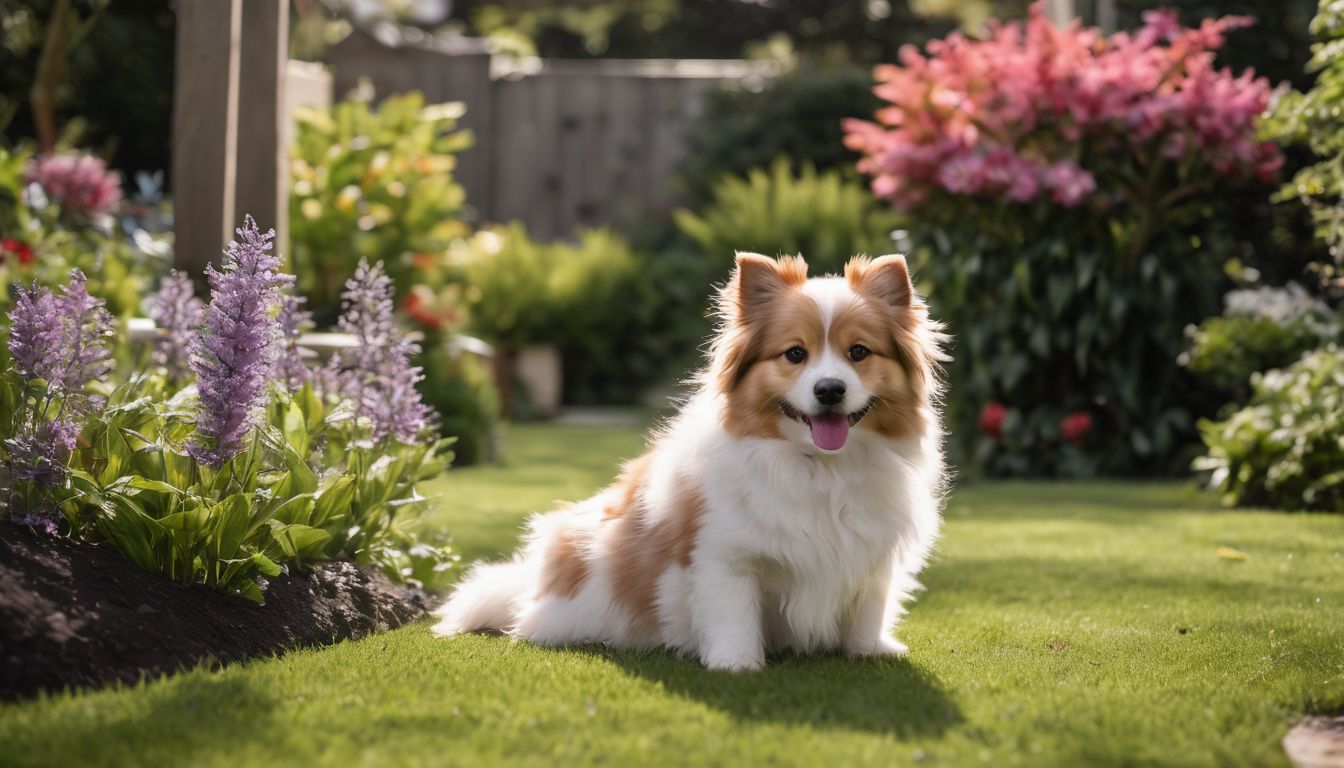City life often leaves little room for nature’s buzz, yet many are seeking ways to bring greenery and wildlife into the urban jungle. Urban beekeeping is on the rise, offering a sweet solution that benefits both people and pollinators.
This article will guide you through how bees can safely share your high-rise haven and why they might be your new favourite neighbours. Dive in to discover a world where concrete meets conservation!
Key Takeaways
- Urban beekeeping in cities supports the local ecosystem by aiding pollination, which enhances green spaces and urban agriculture.
- Beekeepers overcome challenges like finding space for hives and managing human – bee interactions to create a harmonious environment.
- By engaging with nature through urban beekeeping, city residents become more aware of the environmental impact and benefits of bees.
- Educating communities and adhering to laws are key steps for responsible urban beekeeping, ensuring safety for people, pets and bees alike.
- Involving schools, businesses, and local authorities promotes community involvement in creating sustainable habitats for pollinators.
The Rise of Urban Beekeeping
Urban beekeeping has been buzzing into cities, transforming rooftops, balconies, and backyards into vibrant hubs for honeybees. As urban gardens flourish and the trend towards local food grows stronger, city dwellers are embracing the role of beekeeper to support pollination and produce homegrown honey.
This movement isn’t just about producing sweet treats; it’s a step towards sustainable living by fostering urban ecosystems that benefit both people and the environment.
Apartment buildings, offices, and community centres have started installing hives as nature-based amenities to engage tenants and employees. Urban apiculture brings together neighbours who share an interest in environmental conservation while contributing to biodiversity within concrete landscapes.
Moreover, these tiny pollinators play a key part in sustaining urban agriculture through their indispensable service of pollinating plants—ensuring healthy growth of city greenery which often lacks natural pollinators.
Beekeepers in dense metropolises navigate unique challenges yet make a significant impact on boosting urban biodiversity with every hive they manage.
Benefits of Urban Beekeeping
Urban beekeeping provides critical data for pollinator health studies and supports sustainable building initiatives. It also connects city dwellers with nature and engages them with nature-based amenities.
Provides critical data for pollinator health studies
Urban beekeeping plays a crucial role in providing essential data for understanding and improving pollinator health. By studying the behavior and well-being of urban bees, researchers can gather valuable insights into the impact of urban environments on pollinators.
This data helps in identifying stressors, diseases, and environmental factors affecting bee populations, contributing to efforts in developing effective conservation strategies for sustaining healthy pollinator habitats.
Beekeepers and researchers collaborate to monitor urban hives, collecting critical information about their productivity, health status, and interactions with the surrounding environment.
Pollinates urban agriculture and greenery
With their foraging habits, urban bees significantly contribute to the pollination of urban agriculture and green spaces. These industrious creatures play a vital role in increasing crop yield and quality, ensuring the flourishing of community gardens and sustainable urban farming initiatives.
By actively visiting flowers in search of nectar, bees transfer pollen between plants, facilitating the reproduction process crucial for plant growth. Through this natural process, they bolster the greenery within our cities and support local ecosystems.
Their important role in pollinating green spaces not only fosters urban agriculture but also enhances the overall environmental health of our cities.
Connects city dwellers with nature
By pollinating urban agriculture and greenery, urban beekeeping connects city dwellers with nature. This practice allows people living in cities to experience the vital role that bees play in sustaining a healthy ecosystem and food production.
It brings an awareness of the natural world directly into urban environments, fostering a deeper connection between residents and their local ecosystems. Through this connection, individuals can appreciate the significance of maintaining sustainable habitats for bees and other pollinators, ultimately contributing to environmental preservation efforts.
Supporting community gardening initiatives further enhances this connection by involving city dwellers in nurturing green spaces that benefit from urban beekeeping. As more people engage with these initiatives, they become advocates for preserving natural resources within their communities, leading to greater overall environmental consciousness among urban populations.
Supports sustainable building initiatives
Urban beekeeping supports sustainable building initiatives by promoting biodiversity and improving the overall health of urban environments. By pollinating green spaces, gardens, and urban agriculture, bees contribute to a healthier and more resilient ecosystem within the city.
This helps in creating a more sustainable living environment, which is crucial for maintaining a balanced ecological system that benefits both humans and wildlife.
Furthermore, urban beekeeping also raises awareness about the importance of environmental conservation among city dwellers. It encourages people to think about their impact on the environment and inspires them to take meaningful steps towards sustainability.
Engages tenants and employees with nature-based amenities
Nature-based amenities, such as urban beekeeping and green spaces, create a sense of connection with the environment for tenants and employees. Access to these amenities within city environments encourages people to appreciate and engage with nature even in urban settings.
This engagement fosters an understanding of the importance of bees and pollinators in sustaining our ecosystems, promoting a sense of environmental responsibility among individuals residing or working in urban areas.
City dwellers benefit from the calming effect of greenery and the opportunity to learn about sustainable practices like urban gardening. Offering nature-based amenities can enhance well-being while also providing educational opportunities about urban pollination and sustainable beekeeping methods.
Challenges Facing Urban Beekeepers
Hive placement in urban areas can be challenging, as well as managing interactions between humans and bees. Loss of pollinator habitats also poses a significant challenge for urban beekeepers.
https://www.youtube.com/watch?v=DOmbY5uwA1M
Hive placement in urban areas
- Evaluate potential sites for beehive placement based on access to food sources such as nectar and pollen from urban gardens, parks, and trees.
- Consider the distance from high – traffic areas and pedestrian pathways to minimise human disturbance and potential bee stings.
- Ensure that there is adequate space for bees to fly freely without interfering with foot traffic or neighbouring properties.
- Position hives away from areas where pesticides or harmful chemicals are likely to be used to protect the health of the bees.
- Collaborate with local authorities and communities to adhere to regulations regarding hive placement in urban environments, promoting responsible beekeeping practices.
Interactions with humans and bees
- Beekeepers must ensure safe and respectful interactions with their bees to minimise disturbances.
- Providing adequate space for bees to forage and ensuring minimal disruption during hive inspections is essential for promoting the well-being of the colonies.
- Regular monitoring of bee behaviour allows beekeepers to observe any signs of stress or disease within the hive, enabling timely intervention when necessary.
- Educating individuals in urban areas about bee behaviour and safety measures can reduce the risk of negative encounters between humans and bees.
Loss of pollinator habitats
While urban beekeepers face challenges with interactions between humans and bees, another pressing concern is the loss of pollinator habitats. Urban development and habitat destruction have led to a decline in suitable environments for pollinators such as bees, butterflies, and other insects.
The reduction in green spaces and the increasing use of pesticides further exacerbate this issue, impacting the natural ecosystems that support these vital creatures. As cities continue to expand, it becomes crucial to address the loss of pollinator habitats by implementing sustainable urban planning practices and promoting the creation of pollinator-friendly gardens and green spaces within urban areas.
Additionally, preserving existing wild habitats through conservation efforts can provide essential refuges for pollinators. Collaborative initiatives involving local communities, businesses, and government bodies are pivotal in safeguarding these crucial environments.
Misconceptions and Problems with Urban Beekeeping
Urban beekeeping can be perceived as a danger to the public due to misconceptions about bees and their ability to sting. However, with proper management and education, urban beekeeping can be safe for both bees and humans.
Problems may arise from neighbors who are afraid of bees, but open communication and sharing information on the benefits of honeybees can alleviate concerns.
Another misconception is that urban areas are not suitable for beekeeping due to pollution or lack of green space. In reality, cities often provide diverse sources of nectar and pollen for bees, resulting in unique urban honey flavors.
The problems faced by urban beekeepers include finding appropriate locations for hives within limited spaces and managing interactions between humans and bees in densely populated areas.
Laws and Best Practices for Urban Beekeeping
Understanding the laws and regulations around urban beekeeping is crucial to ensure the safety of both humans and bees. Additionally, promoting best practices for managing hives in cities can help build a community that supports and educates others about responsible beekeeping.
Understanding urban beekeeping laws
To comply with urban beekeeping regulations, it’s essential to know the laws and guidelines in your area. Ensure that you understand and adhere to these regulations to support conservation efforts while keeping pets in urban areas. Here are some key points regarding urban beekeeping laws:
- Research local ordinances: Look into the specific regulations for keeping bees in your city or town. It’s important to be aware of any permits, restrictions, or prohibitions related to urban beekeeping.
- Hive placement guidelines: Understand the rules regarding hive placement, including distance requirements from neighbouring properties, public areas, and property boundaries.
- Safety measures: Familiarise yourself with safety protocols for managing bees in densely populated areas. This includes considerations for human interactions and potential allergic reactions.
- Environmental impact assessment: Stay informed about the environmental impact assessments associated with urban beekeeping practices. Understand how these activities contribute to pollinator health and ecological balance.
- Communication with authorities: Establish open communication channels with local authorities responsible for overseeing urban beekeeping activities. This ensures compliance and fosters a positive relationship within the community.
- Community education initiatives: Engage in educational outreach to inform others about the importance of urban beekeeping laws and their significance in promoting environmental sustainability.
Best practices for managing hives in cities
Urban beekeeping requires careful management to ensure the well-being of both bees and city residents. Here are some best practices for managing hives in cities:
- Choose the right location for the hive, ensuring it is away from high-traffic areas and has access to sunlight and water sources.
- Provide a diverse array of plants within flight range of the hive to offer a variety of pollen and nectar forage options.
- Regularly inspect the hive for signs of disease or pests, and take appropriate action if any issues are found.
- Educate neighbors and local community members about the importance of urban beekeeping, addressing any concerns they may have.
- Work with city officials to ensure compliance with local regulations and obtain necessary permits for beekeeping in urban areas.
- Monitor bee behavior regularly to evaluate their overall health, activity, and productivity.
Building community and educating the public about beekeeping
Engage with local schools and community groups to organise educational workshops on urban beekeeping. Encourage public participation in beekeeping projects, allowing individuals to directly contribute to pollinator health studies and environmental conservation efforts.
- Host regular open – house events at urban beekeeping facilities, inviting the public to observe and learn about hive management and bee behaviour.
- Establish mentorship programmes for novice beekeepers, providing hands-on guidance and support from experienced urban beekeepers.
- Collaborate with local authorities to incorporate urban beekeeping into city planning and development initiatives, fostering a greater understanding of the role of bees in sustainable urban environments.
- Create online resources and social media campaigns to raise awareness about the importance of urban beekeeping, promoting responsible practices and dispelling misconceptions surrounding bee behaviour in urban settings.
- Partner with local businesses and community organisations to establish green spaces that prioritise native plant species favoured by pollinators, reinforcing the interconnectedness between urban development and pollinator conservation efforts.
Conclusion
In conclusion, urban beekeeping with pets is gaining popularity among environmentally conscious individuals. It creates a positive impact on the environment by supporting pollinator health and engaging city dwellers with nature-based amenities.
By understanding urban beekeeping laws and implementing best practices, urban beekeepers can effectively manage hives in cities while building community awareness about the importance of beekeeping.
FAQs
1. What is the trend of urban beekeeping with pets?
The trend of urban beekeeping with pets involves keeping beehives in city environments to support local ecosystems, often within people’s backyards alongside their household animals.
2. Can backyard beekeeping cause problems for my pets?
Yes, while backyard beekeeping has many benefits, it can sometimes create issues if pets are not accustomed to or safe around bees, potentially leading to stings or stress.
3. What are some benefits of urban beekeeping?
Urban beekeeping can increase plant pollination in cities, add beauty through gardens that support hives and help maintain healthy local bee populations contributing positively to our environment.
4. How does urban beekeeping impact the environment?
Urban beekeeping positively impacts the environment by aiding plant diversity and growth which supports a richer ecological balance within city landscapes.





